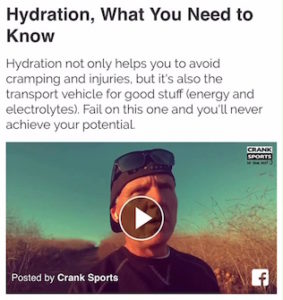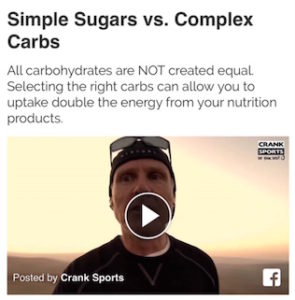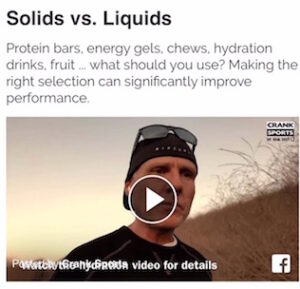Nutrition Keys to Success
Nutrition Keys to Success
In order to achieve optimum performance in any endurance sport (cycling, running, triathlon, soccer, tennis, hockey, etc.) there are five key nutritional objectives that must be achieved. If your nutritional plan is lacking in any one of these areas it will negatively impact your performance, increase the likelihood of injury and/or slow your recovery time, thus impacting your ability to train and compete at optimum levels. The keys are: hydration, energy, electrolytes, oxygen and blood sugar …
1. HYDRATION
objective
Maintain optimum hydration
why?
 Of the five factors, hydration is the most important. Numerous studies have concluded that even mild levels of dehydration will impact your performance1, while more severe cases of dehydration can cause significant health risks or even death. In addition, water is the transport vehicle that delivers the energy and electrolytes into your cellular system, so if you fall behind on your hydration plan then the other areas of your nutrition plan will suffer as well. Remaining properly hydrated also helps to lubricate your working muscles and tendons which is a critical factor in reducing the risk of injury.
Of the five factors, hydration is the most important. Numerous studies have concluded that even mild levels of dehydration will impact your performance1, while more severe cases of dehydration can cause significant health risks or even death. In addition, water is the transport vehicle that delivers the energy and electrolytes into your cellular system, so if you fall behind on your hydration plan then the other areas of your nutrition plan will suffer as well. Remaining properly hydrated also helps to lubricate your working muscles and tendons which is a critical factor in reducing the risk of injury.
how?
Consume 16-32 ounces of hypotonic or isotonic fluid per hour during athletic activity. Adjust intake based on intensity, heat and humidity. For example, if you are going hard and/or it is hot or humid then you should consume toward the higher end of the recommended range (32 oz/hr). Urine color is the best method of determining your hydration. (urine color chart)
2. ENERGY
objective
Achieve maximum energy uptake
why?
Your body has three “on-board” fuel sources: blood sugar, body fat and muscle glycogen. Typically there is approximately 5 grams of glucose (20 calories) circulating in your blood, so blood sugar is not a significant source of energy. Even lean people have plenty of energy in stored body fat (4,000 calories per pound of fat), but fat is a survival fuel and you will not perform at high levels if you are relying on fat as your primary source of energy. If you are properly carbo loaded then you will have approximately 2,000 calories of glycogen stored in your muscles, thus muscle glycogen is your primary “fuel tank”. The problem is that 2,000 calories will only last a few hours depending on athletic activity, intensity, etc. (typical running for example burns 100 calories per mile).
When done properly, consuming carbohydrates during athletic activity will supplement your muscle glycogen and allow you to perform longer at a higher intensity level.
how?
 Unfortunately it’s not as easy as just eating calories. Fats, fibers and proteins have to be digested which detracts from performance (see oxygen discussion below). The ideal solution is liquid carbohydrate calories that are absorbed by osmosis (no digestion required). But it’s still not easy because not all carbohydrates are created equal. Water is the transport vehicle that delivers the carbohydrate energy to your cellular system through the osmosis process, and due to differences in molecular size you can uptake significantly more energy (up to 80% more) when you use complex carbohydrates versus simple sugars. In addition, using multiple types of carbohydrates can increase total energy uptake compared to relying on a single carbohydrate source.
Unfortunately it’s not as easy as just eating calories. Fats, fibers and proteins have to be digested which detracts from performance (see oxygen discussion below). The ideal solution is liquid carbohydrate calories that are absorbed by osmosis (no digestion required). But it’s still not easy because not all carbohydrates are created equal. Water is the transport vehicle that delivers the carbohydrate energy to your cellular system through the osmosis process, and due to differences in molecular size you can uptake significantly more energy (up to 80% more) when you use complex carbohydrates versus simple sugars. In addition, using multiple types of carbohydrates can increase total energy uptake compared to relying on a single carbohydrate source.
So you should:
– Use products with high ratios of complex carbohydrates (look for maltodextrin)
– Avoid products with high sugar levels (no more than 33%)
– Rely on liquid calories with no fats, fibers or proteins
– Use isotonic drinks or proper amounts of water if using energy gels (more info)
– Use products with multiple carbohydrate sources
3. ELECTROLYTES
objective
Maintain balanced electrolyte levels
why?
Endurance athletes sweat … a lot! When we sweat it cools down the body through evaporation, but unfortunately sweat contains critical electrolytes that need to be replaced in order to maintain hydration, avoid cramping and reduce the risk of injury (see hydration discussion). If we drink water it rehydrates us but we don’t get the electrolytes we need.
how?
There are several ways to replenish electrolytes depending on personal preference. Most good sports drinks provide all the electrolytes you need (assuming you drink enough). There are several electrolyte supplements (tablets, pills and powders) to choose from but these take a little more thought because it’s one more thing to buy, transport and figure out how to consume and how often to consume.
If you are an energy gel user then you should be using water and not a sports drink in order to properly absorb the gel (more info), so you either need to use a gel that has the required electrolytes (e-Gel) or you will need to take an electrolyte supplement.
If you use chews, bars and other solid foods they typically do not provide the recommended levels of electrolytes. Most of these products also tend to have high sugar content and low levels of complex carbohydrates (see energy discussion). In addition, most of these products will impact your performance due to digestive requirements of the ingredients (see oxygen discussion).
Recommended Electrolyte Replacement:
500 mg Sodium per liter (34 oz) of consumed fluid
200 mg Potassium per liter (34 oz) of consumed fluid
Other electrolytes including calcium, magnesium and chloride should be incorporated into your recovery nutrition plan and your normal diet but for most athletes there is no benefit of supplementing these electrolytes during your workout or competition.
4. OXYGEN
objective
Maximize oxygen delivery to working muscles
why?
Why did Lance dope? Simple, if you can deliver more oxygen to the working muscles then you will improve your performance, period. Blood doping, EPO, etc., are all designed to do just that. This is important to understand because you very well may be doing things with your nutrition plan that are reducing the availability of oxygen to your muscles.
Every time you breath your lungs pump oxygen into your blood. The blood is then transported (along with the oxygen) to the working muscles. When you do aerobic activity your body will shut down the flow of blood to your stomach in order to maximize the flow of blood (and thus oxygen) to your muscles. The problem occurs when you ingest foods (and/or drinks) that contain fats, fibers, proteins and other ingredients that need to go through a digestive process. Digestion requires blood to be shunted from the muscles and routed back to the gastrointestinal tract (stomach and intestine). This is counterproductive to your athletic activity because your muscles are now performing on a reduced level of oxygen.
This is one of the hardest changes for many endurance athletes to make for one simple reason – when we have food in our stomach we are happy. When our stomach is empty we are hungry and our brain tells us to eat food. If you are going to achieve optimum performance then it is vital that you understand this fact:
There is what your Brain Wants and what your Body Needs, and while you are working out or competing these two things are often diametrically opposed. Your brain wants a happy stomach (food) and our body is craving energy and oxygen delivered to the muscles.
In addition, most solid food that you eat takes so long to digest that it doesn’t have time to help your performance. Did you know that it takes approximately 4 hours and 15 minutes for a banana to leave your stomach? But at least your brain will be happy!
Do yourself a favor, save the solid food as a treat AFTER you finish your workout. This can be a difficult change to make, but try it in your training. You’ll quickly see the difference.
how?
 Stick to liquid carbohydrate fueling with no fats, fibers or proteins.
Stick to liquid carbohydrate fueling with no fats, fibers or proteins.
Liquid carbohydrates (sports drinks or energy gels with water) are absorbed through osmosis which does not require blood like the digestive process does.
Note: if you are an ultra endurance athlete going for 24+ hours or multiple days at a time then this is an exception. Ultra endurance athletes typically perform at a lower intensity level than a marathon runner for example, and thus the body can spare some oxygen to digest the food that is necessary to perform (and survive) over extended periods of time.
5. BLOOD SUGAR
objective
Avoid blood sugar spikes and crashes … the dreaded BONK!!!
why?
If we spike the level of our blood sugar then we have lots of energy … for a little while, and then we come crashing down. This doesn’t work so well for “endurance” athletes.
Simple sugars can do just that, a little bit is okay but too much will quickly raise your blood sugar. If it could stay elevated life would be great, but unfortunately it can’t, and when and comes back down it drops (crashes) well below where it started. You’ve probably experienced this right in your home after giving your kids candy. Or as an adult, we eat a big sugary dessert and then 30 minutes later we fall asleep on the couch.
When this happens during athletic activity it is a dual edged sword. Your performance will drop as the blood sugar drops because your body is depending on that energy, and your body will no longer be able to as efficiently convert your muscle glycogen into usable energy … BONK goes the well trained athlete!!!
how?
The trick is to consume primarily complex carbohydrates that are converted more slowly than simple sugars and thus do not cause rapid spikes and crashes to your blood sugar.
Select products that have a high ratio of complex carbohydrates to simple sugars. To determine the ratio look at the nutrition facts and note these two items:
- Total Carbohydrates (grams)
- Sugars (grams)
If you divide Sugars by Total Carbohydrates that will give you the percentage of simple sugars in the product. If it is more than 33% that is typically the level you want to stay below for an endurance sports nutrition product. If it is 40% or more use at your own risk … BONK!!
Example:
Total Carb 25g
Sugars 5g
5/25 = 20% simple sugar (80% complex carbohydrate)

